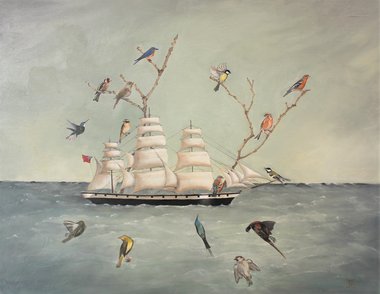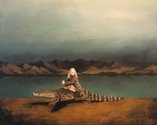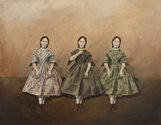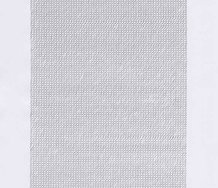Andrew Paul Wood – 29 May, 2020
More specifically, Tennent's paintings fit within the category of the eclectically postmodern new history painting that emerged in New Zealand in the early 1990s as artists like Séraphine Pick, Tony de Lautour, Grant Takle, William Dunning, and later Heather Straka, in response to identity explorations of mana whenua by Shane Cotton, Peter Robinson and Chris Heaphy, began to explore the meaning of Pākehā identity in a similar way, often with gothic and surreal undertones.
Sue Tennent is based in Fairlie in the rural hinterland of Canterbury. The oils in her show Distant Lands at Timaru’s Aigantighe Art Gallery were inspired by nineteenth-century family photographs of her partner and children’s ancestors about to depart for colonial New Zealand. Originally from Australia, a graduate of the University of Queensland with a Bachelor or Design Studies (1983) and a Bachelor of Architecture with First Class Honours (1987) she moved to New Zealand with her family in 2014.
The exhibition is structured like a two act Victorian melodrama with every painting as an individual scene. The first act consisting of thirteen larger, titled paintings, and the second as six small paintings in box frames. The larger paintings find inspiration in snippets of text from issues of the British Empire Gazette from 1864 on, which one assumes is the period Tennet’s partner’s ancestors voyaged out.
The artist describes her influences as botanical drawings, history, fairy tales, paper dolls, ‘Magical Realist’ painting, and Lewis Carroll. I’d venture there’s a strong pinch of Joanna Braithwaite’s particular brand of whimsical surrealism too, particularly in a work like Act 1 - Scene 3 - The Long Farewell, which depicts a tall ship isolated against sea and sky, from which sprout tree branches in which native English songbirds, being transported for introduction and acclimatisation in New Zealand, roost.
In one sense the great great great granddaddy of this particular genre is Ford Maddox Brown’s 1855 painting The Last of England (Birmingham Museum and Art Gallery, UK), a portrait of the Pre-Raphaelite sculptor and poet Thomas Woolner, his wife Alice and their baby son Hugh, windswept and resolute as they sailed to start a new life (at least temporarily) in Australia. There is a Canterbury connection—Woolner was responsible for the statue of John Robert Godley in Christchurch in Cathedral Square.
More specifically, Tennent’s paintings fit within the category of the eclectically postmodern new history painting that emerged in New Zealand in the early 1990s as artists like Séraphine Pick, Tony de Lautour, Grant Takle, William Dunning, and later Heather Straka, in response to identity explorations of mana whenua by Shane Cotton, Peter Robinson and Chris Heaphy, began to explore the meaning of Pākehā identity in a similar way, often with gothic and surreal undertones.
The gothic sensibility fed into a kind of Victorian pastiche has found particular currency in a diversity of creative expressions from Stewart Main and Peter Wells’ 1993 movie Desperate Remedies through to Eleanor Catton’s 2013 Man Booker-winning novel The Luminaries and its 2020 televisual reincarnation. Aestheticised thus, it allows artists and writers to explore the contested territory of the colonial past.
Tennent has a very precise eye for detail. The enigmatic children in some of the paintings have clearly been copied from old photographs as if they were appliqued down on the painted surface, and surprisingly enough the conscious artifice of it works quite well. Playful visual metaphors are often involved, derived from the tropes of Victorian novelty photography—the Alicesque girl riding the crocodile in Act 1 - Scene 1 - The Long Farewell or the children standing on the giant waterlily pads (Victoria amazonica) in Act 1 - Scene 4 - The Exotic Intruders.
In the same way, Tennent accurately captures the techniques of the amateur colonial painter or Colin McCahon’s mid-career approach to modelling landscape. This is one of the great visual delights of the work; her ability to create an aesthetically pleasing synthesis from the bricolage.
Andrew Paul Wood



 Two Rooms presents a program of residencies and projects
Two Rooms presents a program of residencies and projects Advertising in this column
Advertising in this column



This Discussion has 0 comments.
Comment
Participate
Register to Participate.
Sign in
Sign in to an existing account.